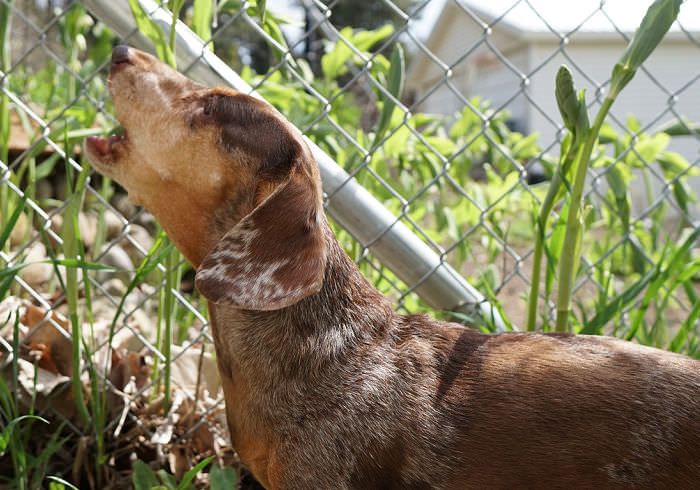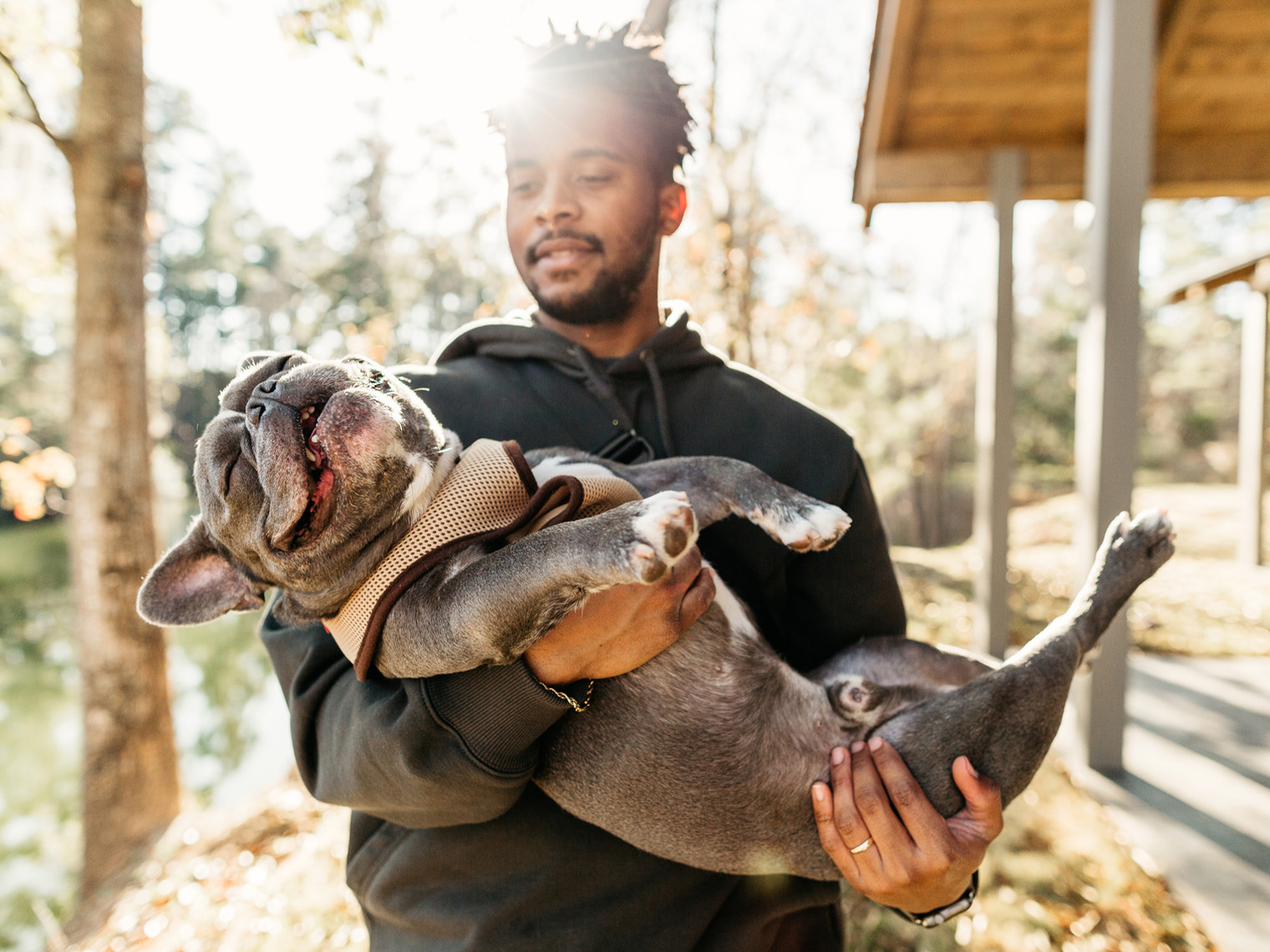Pet owners who are frustrated with their Dachshund’s behavior often seek out a dog trainer for help. The owners have usually been living with an issue for a long time, have reached a point of desperation, and want or need a fix now.
There are two primary ways that dog trainers can help – they can do the training themselves and then explain how to maintain the training at home, or they can coach the owner through training the dogs themselves from the outset.
The two things that these strategies have in common are that YOU will be doing some or all of the training and they require time and money.

I’ve been immersed in the dog training world for a few years now, and the biggest barrier I see to lasting behavior change is owners not wanting to, or being able to, commit enough time to successfully implement a behavior modification plan.
But what if your Dachshund’s behavior issues isn’t a training problem? What if training is just a temporary band-aid and the issue keeps resurfacing in other ways, or gets worse, because the underlying issue has not been addressed?
What if you could change your dog’s behavior without any training at all?
Let me explain.
1) Misbehavior Can Actually Be a Medical Issue
Dogs don’t have words to tell us when they’re sick.
In the beginning, when the issue is minor, a dog may look fine on the outside, but they can start showing signs they are unwell through their behavior.
Think about how you may be short or irritable with someone at the grocery store if you have a headache or woke up with a headache.
Dogs can be irritable too when they don’t feel well. They may bark more frequently, they may may misbehave on the leash, they may start constantly licking things.
If their mental or physical health gets worse, a dog can really start acting out – doing things they never did before like growling, biting, and being aggressive.
The first thing to do if you have noticed a behavior change in your Dachshund, especially if it is sudden, is to take your dog to the vet to rule out an underlying medical issue.
Your veterinarian will thoroughly examine your dog’s body, and listen to their lungs and heart, to see if they can detect any abnormalities. The next step is usually a full blood test panel to “check” how your dog’s organs are functioning.
If you or your vet still suspect something is wrong with your dog, your vet may take x-rays to rule out orthopedic issues not detected with a manual exam, or order more extensive diagnostics.
Typically, if nothing abnormal is detected, it’s not likely that your dachshund’s behavior is caused by them not feeling well.
However, if your vet does detect a health issue and you address it, your dog may go back to acting normally. Behavior problem solved without training!
If underlying medical causes have been ruled out and your dog is still misbehaving, it’s time to take the next step in the “bad behavior solution hierarchy”.
Unmet Needs Manifest as Naughty Behavior
A Dachshund’s “needs” refers to their biological, genetic, and historically learned behaviors that are automatic and compulsory.
Put another way, these are things a Dachshund is compelled to do, and need, whether they live on a farm or live in an apartment. These are automatic “wants” that they literally can’t help.
What are a Dachshund’s needs?
I recently completed the Family Dog Mediation® Professional Course. It’s based on the L.E.G.S.® framework developed by Kim Brophy, a dog behavior expert and applied ethologist.
Kim created the L.E.G.S. model to help people understand how/why dogs think and behave the way that they do by looking at four key factors:
- Learning – What is our dog’s learning history?
- Environment – What environment is our dog living in now?
- Genetics – What has our dog been bred to do? What feels intrinsically good to them?
- Self – Who is this dog? What makes them unique?
I don’t want to get caught in the weeds of the science behind this, and how to apply this framework (set up a call with if you want to consult with me about your Dachshund), but the important thing to know is this:
Your dog has intrinsic needs based on their biological drive, the purpose they were bred for, and their individual personality and experiences.
Setting aside the debate about whether a Dachshund is more scent hound or terrier, it’s important to recognize that the breed is some combination of both, and still maintains some traits from each breed group.
The genetic instincts of a Dachshund include “impulsive and emotional nature for pursuit “ (scent hound) and “very impulsive and instinctual around small animals” (terrier).
Are you already seeing your Dachshund’s behavior in a new light? It’s no wonder that your doxie loses their mind around squirrels or wants to chase your cat!
Furthermore, common behavior traits include:
- Scent hound: social, emotional, fun, impulsive, dramatic.
- Terrier: dynamic, independent, hyperactive, one-track mind.
Now, do you see it? To me, these traits pretty much describe all Dachshunds at their core.
The natural instincts of Dachshunds includes mental/physical/instinctual needs and social needs.
- Mental/physical/instinctual needs – predatory drive (specifically the orient, chase, grab-bite, kill-bite, and dissect parts of the predatory sequence), and physical activity (driven primarily be the history as a hunting breed).
- Social needs – interaction with both other dogs and humans (they often worked in small groups of dogs, and formed strong attachments to their owners and handlers, during hunts).
In order for a Dachshund to be fulfilled, they must be given acceptable outlets to satisfy these natural instincts.
Because Dachshunds today are primarily kept as pets, and many, many of them live in urban environments, their ability to satisfy their needs themselves is extremely limited.
That’s where you come in!
2) Meet Your Dachshund’s Needs to Help Prevent Naughty Behavior
The second way that you may be able to effect positive change on your Dachshund’s misbehavior without training is through life enrichment.
Enrichment is a blanket term for the concept of giving your animals proper outlets for their internal, instinctual needs. For more details about this practice and how it applies to pets, read my article about the history and premise behind dog enrichment.
I wrote a whole article listing many breed-specific enrichment activities for Dachshunds, and included a brief explanation of which needs each one meets, so I am not going into go into how to meet your Dachshund’s needs in this article. I want to focus on the why.
You must understand this: If you don’t give your Dachshund a proper outlet to fulfill their needs, they can get frustrated, anxious, and may find ways to meet these needs on their own, which often conflict with our own needs!
So many things we see as “bad behavior” may actually your dog’s attempts to meet their own needs. In other words, they aren’t trying to be bad, they are trying to improve their own wellbeing because you are not providing proper outlets for them.
The problem is, we often don’t like the things our dogs do to meet their own needs. We may find them annoying, frustrating, and, sometimes, dangerous.
We try to suppress these behaviors, or at worst punish them, not realizing that they actually serve an important purpose for our dogs.
These behaviors include:
- Pulling on leash
- Excessive barking
- Chewing, digging and other destructive behavior
- Getting into trash
- Not coming back when called (finding a scent more interesting than you are)
Simply enriching your Dachshund’s life – expanding their “world” and providing satisfying activities for them, can improve their behavior without having to do any training at all.
While enriching your dog’s life may not eliminate behavior problems and the need to consult with a trainer, it can absolutely make a small difference.
Final Thoughts
When you want a fix for your Dachshund’s bad behavior, training might be the first place your mind goes. But it turns out that training might not solve the issues. At least not permanently.
Why jump right to spending a lot of money and time for someone else to “fix” your dog or to coach you through how to do it yourself instead of trying to address the root of the problem first?
The first step should be taking your Dachshund to the vet to see if there are any underlying medical issues that may be causing your dog to be irritable, anxious, and to act out. The vet can either rule out that possibility or treat the condition.
If there appears to be no underlying medical cause, then owners should look at what kind of opportunities their Dachshund has to meet their instinctual needs in a healthy and appropriate way.
Ignoring a dog’s natural drives doesn’t make them go away. It just makes them show up in sometimes strange ways that we often find frustrating or bewildering (why is my dog always doing *insert the bad thing we don’t want*).
If after trying those two things, your Dachshund is still doing things that you don’t like, definitely reach out for help.
Continuing to live with the frustration or helpless feeling can damage your relationship with your Dachshund.
It can also mean that you and your dog live a significant restricted life because your dog too difficult to take out in public or you are too fearful or embarrassed to have guests over to your house.
There is no need to live like that!




